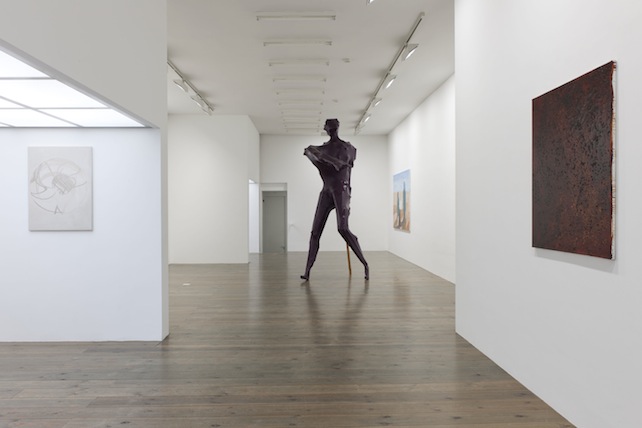
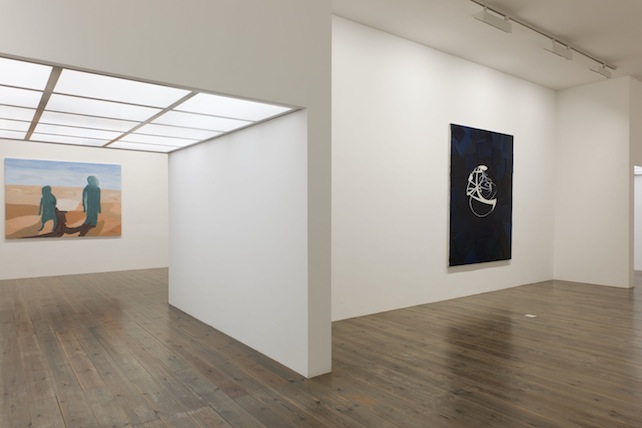
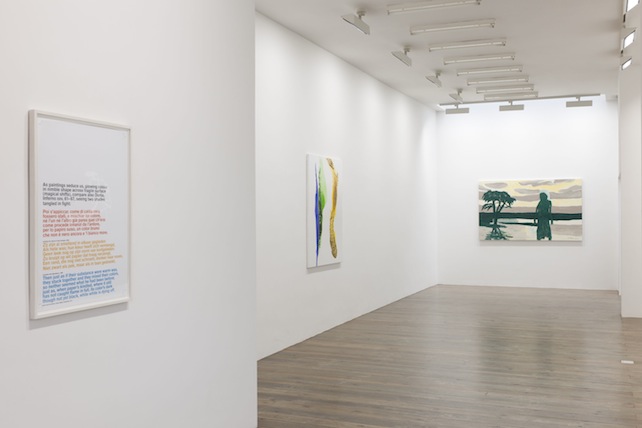
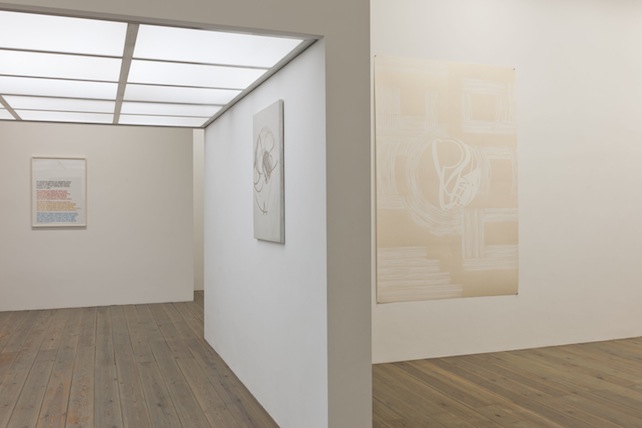
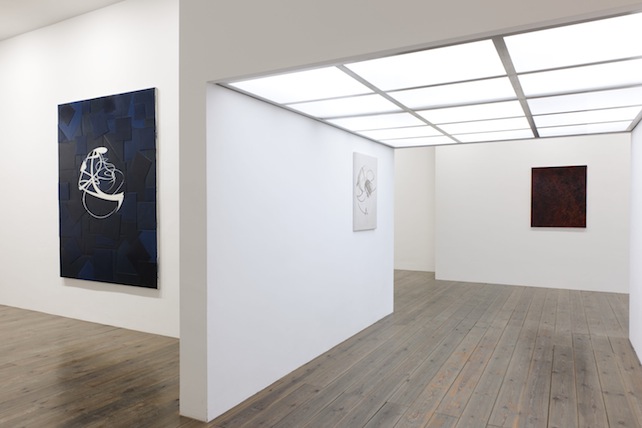
Couplet 7: Karel Appel, Domenico Bianchi, Georg Herold (Curator: Rudi Fuchs)
Slewe Gallery is pleased to announce the opening of a special exhibition curated by former Stedelijk Museum director Rudi Fuchs, entitled Couplet 7. Participating artists are Karel Appel (1921-2006, NL), Domenico Bianchi (*1955, IT) and Georg Herold (*1947, DE). The exhibition will open Saturday November 19 and will last until December 17, 2011.
The title of the exhibition refers to the famous series of Couplet exhibitions Rudi Fuchs curated at the Stedelijk Museum Amsterdam in the nineties of the last century. In these highly esthetic exhibitions he pointed out his unconvential vision, in which juxtaposted art works showed surprising dialogues, visually as well as in content. With a selection of recent never shown works by Appel, Bianchi and Herold Couplet 7 is a follow up of these series in a condensed form.
Of Karel Appel, the great Dutch expressionist painter who died in 2006, two of his last and never exhibited paintings from 2004 will be shown. They are monumental works depicting a standing figure in a landscape.
The Italian artist Bianchi will show two newly made works. He has developed his own technique of mixing wax and oil paint, sometimes combined with Palladium leaf. His images with a perpetuum mobile motive derive from computer programs.
Herold, known for his sculptures and assembled paintings with unconventional materials, such as bricks, caviar, vodka-bottles and mattresses, will show a new sculpture of a 3 meters high standing figure. His work has a relation to arte povera, but also bears political connotations as a result of his East German background.
Rudi Fuchs has written a special statement for this exhibition. Especially designed by Irma Boom it will be part of the show.
Slewe Gallery is pleased to announce the opening of the exhibition with new works by the German artist Günter Tuzina (*1951). The exhibition will open Saturday October 15 and will last until November 12, 2011. At the same time he has a presentation in the Project Room of the Gemeentemuseum The Hague, following the purchase of a monumental floor relief. Also lasting until November 12, 2011.
The very refined drawings and paintings by Tuzina show the inheritance of the minimalist idiom of the sixties and seventies. His rectangled drawings in mostly dark blue and green colors look like windows. They are cut by expressive horizontal, vertical and diagonal lines. These lines and angles are not quite perfect, which give them an emotional significance. It contrasts sharply with the anonymous, industrial perfection of Minimal Art.
During the exhibition an interview with the artist will be made and shown as a video through vimeo on internet. This will be the second in the series of artists’ interviews, which art critic Robert-Jan Muller will make for the gallery.
Günter Tuzina, born in 1951 in Hamburg, lives and works in Cologne in Germany. This exhibition is his fourth presentation at Slewe. In 2002 he had an overview of his oeuvre in the Gemeentemuseum The Hague, on which occasion also a catalog had been published. His works have been internationally shown and collected by several museum and public collections such as the Gemeentemuseum The Hague and the Stedelijk Museum Amsterdam.
Slewe Gallery is pleased to announce the opening of Time Trials by Dan Walsh (*1960, USA). Walsh, known for his playful minimal abstract paintings, will focus this time on a more conceptual and experimental exhihibition. The exhibition will open Saturday September 10 and will last until October 8, 2011.
Like his exhibition 7 Grays at Paula Cooper Gallery in New York and Synagogue de Delme, and his experimental installation at CCNOA in Brussels with Olivier Mossett in 2002, Walsh continues his interest in occupying the field of the spectator. In Time Trials, Walsh assembles a collection of objects and visual aides (found and made) creating scenarios or concentrated tableaux to help look at the subject of time. It is as experiential as it is reflective. Examples include such everyday mechanisms as clocks and metronomes, as well as complex concepts such as cultural cycles and interior time. One views these subjects through camera lenses as well as historical lenses (like a sepia film gel.) It is encyclopedic in its references and contexts, seemingly didactic in its use of tripods and maps, but deceptive in its inconclusiveness.
Walsh is one of the most remarkable abstract artists in the United States. Showing since 1993 at Paula Cooper Gallery in New York and several galleries in Europe, such Galerie Tschudi in Glarus/Zuoz (CH) and Xippas in Paris, this exhibition will be his fourth show at Slewe in Amsterdam. His work has been collected by several internationally important private and public art collections, such as the MoMA in New York, Saatchi in London, FNAC in Paris and AKZO Nobel Art Foundation in Amsterdam. He lives and works in Brooklyn, New York.
During the exhibiton a video interview ill be made by the Dutch art critic Robert-Jan Muller, on view at vimeo. It will be the first one in the new series artists' interviews he will make especially for the gallery.
Slewe Gallery is pleased to announce the opening of the exhibition with new works by the British artist Alan Charlton (*1948, Sheffield). The exhibition will show eight new Grid paintings, especially made for this occasion. It will open Saturday May 7 and will last until June 6, 2011.It will be his first show in Amsterdam again since his solo exhibition at the Stedelijk Museum Amsterdam in 2001.
Alan Charlton is one of the most famous representatives of the minimal and conceptual art in England. For more than 40 years his work consists of pure monochrome grey paintings, made with acrylic paint on canvas. When he was twenty-one years old, while still studying at the Camberwell School of Art, he took the decision to make only grey paintings. For Charlton the color grey is the most emotional and diverse color. All his works are based on the module of 4,5 cm. Their balanced compostions of mostly several grey panels give the paintings a monumental and specific expression.
Since the seventies Charlton had numerous important museum and gallery shows internationally. In the Netherlands he had solo shows at Art & Project and at the Stedelijk Museum Amsterdam and Van Abbemuseum, in Germany at Konrad Fischer Galerie and recently at Musuem Kurhaus Kleve. In Italy at Castello di Rivoli, Torino, in Switserland at galerie Tschudi and in London at Annely Juda Gallery and at the Tate. His work has been collected worldwide by prestigious public and private collections.
Slewe Gallery is pleased to announce the opening of the exhibition with new paintings by Dutch artist Joris Geurts (*1958, NL). The exhibition will open Saturday March 26 and will run until April 29, 2011.
Joris Geurts is known for abtstract paintings, drawings and prints. They are assiociatively built up, but transparantly layered and traceble. Small squares and dots float on deep blues and greens, giving associations with the kosmos or landscape. In his new series paintings parts of the surface of the raw linen have been left open and become an important visual element.
After his study at the AKI in Enschede, Geurts started his career in the eighties at Art & Project Gallery in Amsterdam. Since 1995 he showed regularly at Slewe Gallery. In 2001 he had a show at Noordbrabants Museum in ’s-Hertogenbosch, on which occasion a catalog had been published Purple Blue and Lemon Yellow, giving an overview of his work, wth texts by Bert Jansen and Henk van Woerden. In addition to his painting practice he also works as a composer of music. His works have been collected by several important public collections, such as the Stedelijk Museum Amsterdam, Museum Boijmans van Beuningen, Rotterdam, Rijksmuseum Twenthe, Enschede and the corporate art collections of the AKZO Nobel, ABN AMRO, KPN, Bouwfonds and AEGON.
Slewe Gallery is pleased to announce the opening of the exhibition with new works by German born artist Alice Schorbach. The exhibition will open Saturday February 19 and will run through March 19, 2011. Art historian Pauli Snoeks, who has done a study on the work by Schorbach, will give an introduction at the opening on Saturday February 19 at 4 pm.
Schorbach’s works consist of geometric, abstract combinations of canvas-stretched wooden frames that assume an object-like character. On first glance one sees a monochrome surface comprised of a variety of shades of color that the artist has applied in several coats of tempera with great care and precision. The different components within the works vary in size and thus the incidence of light and the effect of shadow play an important role. The color applied to the sides of the paintings attains a free, independent existence both on the underlying wall and in the architectural space in which the works are presented.
Schorbach, born in 1940 in Kassel (DE), lives and works since 1970 in Amsterdam. In 1977 she participated at the Documenta VI. In addition to exhibitions in Germany and Switserland, she exhibited regularly in the Netherlands at Slewe Gallery since 1994. In 2007 she had a solo show at the Rijksmuseum Twenthe, on wich occasion a catalog had been published.
Why Patterns?
Participating artists: James Siena, Daan van Golden, Ian Davenport, Ann Pibal, Jerry Zeniuk, Carel Blotkamp, Michael Jacklin, Irma Boom, Joris Geurts, Jorinde Voigt, Stephen Ellis, Jan Dibbets, Martin Gerwers, Xylor Jane, Peter Struycken, Kate Shepherd, Domenico Bianchi, Merina Beekman, Callum Innes, Ditty Ketting, Peter Davis, Kees Goudzwaard, Dan Walsh, Herman de Vries, Steven Aalders
On Saturday 8 January 2011, Slewe Gallery will start out the new year with a group exhibition based on a concept of Steven Aalders:
I went to Zuiderwoude to attend a concert. Morton Feldman's Why Patterns? was being performed. Flute, piano and glockenspiel played individual notes, seemingly unrelated to each other. Only toward the end did the lines converge. Afterwards I cycled home across the dike, the sounds still echoing in my mind. Like a big whitish blue question mark, the IJsselmeer lay to the left, its silvery surface fractured into a fine relief of little waves. Above it moved the clouds in ever-changing formations. Straight lines of polder landscape on the right, dotted with red roofs, and the truncated tower of Ransdorp in the distance. Now and then September light skimmed across the pastures and gave the land a golden blush. "God was great that afternoon," said Nescio, "and benevolent."
Since the beginnings of abstract art, artists have made use of patterns in order to incorporate the problem of figure and background into the two-dimensional surface. They often took inspiration from non-Western visual cultures, as seen in the patterns of oriental carpets or Pre-Columbian objects. Patterns were also employed as independent elements in order to portray growth processes and cycles in nature, as parallels to nature's own manifestations.
The exhibition includes works by twenty five guest and regularly shown artists of the gallery. Patterns, both concrete and ephemeral, set the tone.
On Sunday afternoon 9 January, at 4 pm, the work Why Patterns? by the American composer Morton Feldman (1926-1987) will be performed by the Ives Ensemble in the gallery. Admission is free. (rsvp: info@slewe.nl).